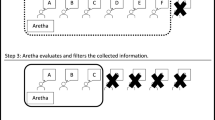Abstract
I focus my discussion on the well-known Ellsberg paradox. I find good normative reasons for incorporating non-precise belief, as represented by sets of probabilities, in an Ellsberg decision model. This amounts to forgoing the completeness axiom of expected utility theory. Provided that probability sets are interpreted as genuinely indeterminate belief (as opposed to “imprecise” belief), such a model can moreover make the “Ellsberg choices” rationally permissible. Without some further element to the story, however, the model does not explain how an agent may come to have unique preferences for each of the Ellsberg options. Levi (1986, Hard choices: Decision making under unresolved conflict. Cambridge, New York: Cambridge University Press) holds that the extra element amounts to innocuous secondary “risk” or security considerations that are used to break ties when more than one option is rationally permissible. While I think a lexical choice rule of this kind is very plausible, I argue that it involves a greater break with xpected utility theory than mere violation of the ordering axiom.
Similar content being viewed by others
References
Bandyopadhayay, P. S. (1994). In search of a pointless decision principle. PSA: Proceedings of the biennial meeting of the philosophy of science association 1994 (Volume 1: Contributed Papers), pp. 260–269.
Broome J. (1991). Weighing goods: Equality, uncertainty and time. Oxford, Cambridge, MA: Basil Blackwell Ltd.
Ellsberg D. (1961). Risk, ambiguity, and the savage axioms. The Quarterly Journal of Economics, 75(4):643–669
Gärdinfors P., Sahlin N.E. (1982). Unreliable probabilities, risk taking and decision making. Synthese, 53, 361–386
Gillies D. (2000). Philosophical theories of probability. London and New York,Routledge
Hájek, A. (2003). Conditional probability is the very guide of life. In H. E. Kyburg, & M. Thalos (Eds.), Probability is the very guide of life: The philosophical uses of chance. Chicago and La Salle, Ill.: Open Court.
Hammond P.J. (1988). Orderly decision theory: A comment on professor Seidenfeld. Economics and Philosophy, 4, 292–297
Howson, C., & Urbach P. (1989). Scientific reasoning: The Bayesian approach. La Salle, III.: Open Court.
Jeffrey, R. (1982). The sure thing principle. PSA: Proceedings of the biennial meeting of the philosophy of science association 1982 (Volume Two: Symposia and Invited Papers), pp. 719–730.
Joyce J.M. (1999). The foundations of causal decision theory. Cambridge, New York, Cambridge University Press
Kyburg H.E. (1983). Rational belief. The Behavioral and Brain Sciences, 6, 231–273
Levi I. (1974). On indeterminate probabilities. Journal of Philosophy, 71(13):391–418
Levi I. (1980). The enterprise of knowledge. Cambridge, Mass, MIT Press
Levi I. (1985). Imprecision and indeterminacy in probability judgment. Philosophy of Science, 52(3):390–409
Levi I. (1986). Hard choices: Decision making under unresolved conflict. Cambridge, New York, Cambridge University Press
Levi I. (1997). The covenant of reason. Cambridge, Cambridge University Press
MacCrimmon K.R., Larsson S. (1979). Utility theory: Axioms versus ‘paradoxes’. In: Allais M., Hagen O. (eds) Expected utility and the allais paradox. Dordrecht Boston, Reidel Publishing Company
McClennen E.F. (1988). Ordering and independence: A comment on Professor Seidenfeld. Economics and Philosophy, 4, 298–308
Raiffa H. (1968). Decision analysis: Introductory lectures on choices under uncertainty. Reading, Mass, Addison-Wesley
Ramsey F.P. (1926). Truth and probability. In: Braithwaite R.B. (eds) Foundations of mathematics. New York, Humanities Press
Savage L.J. (1954). The foundations of statistics. New York, Wiley
Seidenfeld T. (1983). Decisions with indeterminate probabilities. The Behavioral and Brain Sciences, 6, 259–261
Seidenfeld T. (1988). Decision theory without “Independence” or without “Ordering”. Economics and Philosophy, 4, 267–290
Seidenfeld T., Kadane J.B., Schervish M.J. (2004). A Rubinesque theory of decision. IMS Lecture Notes Monograph, 45, 1–11
Shafer G. (1986). Savage revisited. Statistical Science, 1(4):463–485
Walley P. (1991). Statistical reasoning with imprecise probabilities. London, Chapman & Hall
Weatherson B. (2002). Keynes, uncertainty, and interest rates. Cambridge Journal of Economics, 26, 47–62
Weirich P. (1986). Expected utility and risk. British Journal for the Philosophy of Science, 37(4):419–442
Weirich P. (2001). Risk’s place in decision rules. Synthese, 126, 427–441
Weirich P. (2004). Realistic decision theory. Oxford, Oxford University Press
Author information
Authors and Affiliations
Corresponding author
Rights and permissions
About this article
Cite this article
Steele, K. Distinguishing indeterminate belief from “risk-averse” preferences. Synthese 158, 189–205 (2007). https://doi.org/10.1007/s11229-006-9119-8
Received:
Accepted:
Published:
Issue Date:
DOI: https://doi.org/10.1007/s11229-006-9119-8




